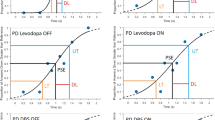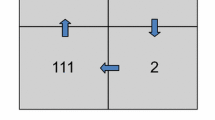Abstract
Interval timing deficiencies in Parkinson’s disease (PD) patients have been a matter of debate. Here we test the possibility of PD heterogeneity as a source for this discrepancy. Temporal performance of PD patients and control subjects was assessed during two interval tapping tasks and during a categorization task of time intervals. These tasks involved temporal processing of intervals in the hundreds of milliseconds range; however, they also covered a wide range of behavioral contexts, differing in their perceptual, decision-making, memory, and execution requirements. The results showed the following significant findings. First, there were two clearly segregated subgroups of PD patients: one with high temporal variability in the three timing tasks, and another with a temporal variability that did not differ substantially from control subjects. In contrast, PD patients with high and low temporal variability showed similar perceptual, decision-making, memory, and execution performance in a set of control tasks. Second, a slope analysis, designed to dissociate time-dependent from time-independent sources of variation, revealed that the increase in variability in this group of PD patients was mainly due to an increment in the variability associated with the timing mechanism. Third, while the control subjects showed significant correlations in performance variability across tasks, PD patients, and particularly those with high temporal variability, did not show such task correlations. Finally, the results showed that dopaminergic treatment restored the correlation effect in PD patients, producing a highly significant correlation between the inter-task variability. Altogether, these results indicate that a subpopulation of PD patients shows a strong disruption in temporal processing in the hundreds of milliseconds range. These findings are discussed in terms of the role of dopamine as a tuning element for the synchronization of temporal processing across different behavioral contexts in PD patients.






Similar content being viewed by others
Abbreviations
- PD:
-
Parkinson’s disease
- UPDRS:
-
Unified Parkinson disease rating scale
- MTT:
-
Multiple tap task
- STT:
-
Single tap task
- CAT:
-
Interval categorization task
- SD:
-
Standard deviation
- BGTCP:
-
Basal ganglia-thalamocortical pathway
References
Artieda J, Pastor MA, Lacruz F, Obeso JA (1992) Temporal discrimination is abnormal in Parkinson’s disease. Brain 115:199–210
Bandini F, Pierantozzi M, Bodis-Wollner I (2002) The visuo-cognitive and motor effect of amantadine in non-caucasian patients with Parkinson’s disease. A clinical and electrophysiological study. J Neural Transm 109:41–51
Beck AT, Ward C, Mendelson M (1961) Beck depression inventory (BDI). Arch Gen Psychiatry 4:561–571
Benedict RHB, Schretlen D, Groninger L, Hopkins BJ (1998) Verbal learning test—revised: normative data and analysis of inter-form and test–retest reliability. Clin Neuropsychol 12:43–55
Braver TS, Barch DM, Gray JR, Molfese DL, Snyder A (2001) Anterior cingulate cortex and response conflict: effects of frequency, inhibition and errors. Cereb Cortex 11:825–836
Brown P (2003) Oscillatory nature of human basal ganglia activity: relationship to the pathophysiology of Parkinson’s disease. Mov Dis 18:357–363
Buhusi CV, Meck WH (2002) Differential effects of methamphetamine and haloperidol on the control of an internal clock. Behav Neurosci 116:291–297
Buhusi CV, Meck WH (2005) What makes us tick? Functional and neural mechanisms of interval timing. Nat Rev Neurosci 6:755–765
Buonomano DV, Karmarkar UR (2002) How do we tell time? Neuroscientist 8:42–51
Cassidy M, Mazzone P, Oliviero A, Insola A, Tonali P, Di Lazzaro V, Brown P (2002) Movement-related changes in synchronization in the human basal ganglia. Brain 125:1235–1246
Cassim F, Labyt E, Devos D, Defebvre L, Destée A, Derambure P (2002) Relationship between oscillations in the basal ganglia and synchronization of cortical activity. Epilepsy Dis 4:31–45
Church RM, Deluty MZ (1977) Bisection of temporal intervals. J Exp Psychol Anim Behav Process 3:216–228
Duchek JM, Balota DA, Ferraro FR (1994) Component analysis of a rhythmic finger tapping task in individuals with senile dementia of the Alzheimer’s type and in individuals with Parkinson’s disease. Neuropsychology 8:218–226
Elsinger CL, Rao SM, Zimbelman JL, Reynolds NC, Blindauer KA, Hoffman RG (2003) Neural basis for impaired time reproduction in Parkinson’s disease: an fMRI study. J Int Neuropsychol Soc 9:1088–1098
Folstein MF, Folstein SE, McHugh PR (1975) ‘Mini-mental state’: a practical method for grading the cognitive state of patients for the clinician. J Psychiatr Res 12:189–198
Foltynie T, Brayne C, Barker RA (2002) The heterogeneity of idiopathic Parkinson’s disease. J Neurol 249:138–145
Gibbon J (1977) Scalar expectancy theory, Weber’s law in animal timing. Psychol Rev 84:279–325
Gibbon J, Malapani C, Dale CL, Gallistel C (1997) Toward a neurobiology of temporal cognition: advances and challenges. Curr Opin Neurobiol 7:170–184
Goldman-Rakic PS, Castner SA, Svensson TH, Siever LJ, Williams GV (2004) Targeting the dopamine D1 receptor in schizophrenia: insights for cognitive dysfunction. Psychopharmacology (Berl) 174:3–16
Grant DA, Berg EA (1948) A behavioral analysis of the degree of reinforcement and ease of shifting to new responses in a Weigl-type card sorting problem. J Exp Psychol 38:404–411
Harrington DL, Haaland KY (1999) Neural underpinnings of temporal processing: a review of focal lesion, pharmacological, and functional imaging research. Rev Neurosci 10:91–116
Harrington DL, Haaland KY, Hermanowicz N (1998) Temporal processing in the basal ganglia. Neuropsychology 12:3–12
Hazeltine E, Helmuth LL, Ivry RB (1997) Neural mechanisms of timing. Trends Cogn Sci 1:163–169
Heaton RK, Chelune GI, Talley JL, Kay GG, Curtiss G (1993) Wisconsin card sorting test manual. Psychological Assessment Resources, Odessa
Ivry RB, Hazeltine RE (1995) Perception and production of temporal intervals across a range of durations: evidence of a common timing mechanism. J Exp Psychol Hum Percept Perform 21:3–18
Ivry RB, Keele SW (1989) Timing functions of the cerebellum. J Cogn Neurosci 1:136–152
Johnson RA, Wichern DW (1998) Applied multivariate statistical analysis. Prentice Hall, NJ
Keele S, Nicoletti R, Ivry R, Pokorny R (1985) Do perception and motor production share common timing mechanisms: a correlational analysis. Acta Psychol 60:173–191
Klockgether T, Borutta M, Rapp H, Spieker S, Dichgans J (1995) A defect of kinesthesia in Parkinson’s disease. Mov Disord 10:460–465
Lewis SJG, Foltynie T, Blackwell AD, Robbins TW, Owen AM, Barker RA (2005) Heterogeneity of Parkinson’s disease in the early clinical stages using a data driven approach. J Neurol Neurosurg Psychiatry 76:343–348
Lezak MD, Howieson DB, Loring DW (2004) Neuropsychological assessment, 3rd edn. Oxford University Press, Oxford
Malapani C, Rakitin B, Levy R, Meck WH, Deweer B, Dubois B, Gibbon J (1998) Coupled temporal memories in Parkinson’s disease. A dopamine-related dysfunction. J Cogn Neurosci 10:316–331
Maricq AV, Church RM (1983) The differential effects of haloperidol and methamphetamine on time estimation in the rat. Psychopharmacology (Berl) 79:10–15
Meck WH (1996) Neuropharmacology of timing and time perception. Cogn Brain Res 3:227–242
Meck WH (2006a) Frontal cortex lesions eliminate the clock speed effect of dopaminergic drugs on interval timing. Brain Res 1108:157–167
Meck WH (2006b) Neuroanatomical localization of an internal clock: a functional link between mesolimbic, nigrostriatal, and mesocortical dopaminergic systems. Brain Res 1109:93–107
Meck WH, Benson AM (2002) Dissecting the brain’s internal clock: how frontal-striatal circuitry keeps time and shifts attention. Brain Cogn 48:195–211
Meck WH, Malapani C (2004) Neuroimaging of interval timing. Cogn Brain Res 21:133–137
O’Boyle DJ, Freeman JS, Cody FW (1996) The accuracy and precision of timing of self-paced, repetitive movements in subjects with Parkinson’s disease. Brain 119:51–70
Pastor MA, Jahanshahi M, Artieda J, Obeso JA (1992a) Performance of repetitive wrist movements in Parkinson’s disease. Brain 115:875–891
Pastor MA, Artieda J, Jahanshahi M, Obeso JA (1992b) Time estimation and reproduction is abnormal in Parkinson’s disease. Brain 115:211–225
Pekkonen E, Ahveninen J, Virtanen J, Teravainen H (1998) Parkinson’s disease selectively impairs preattentive auditory processing: an MEG study. Neuroreport 9:2949–2952
Petrides M (1997) Visuo-motor conditional associative learning after frontal and temporal lesions in the human brain. Neuropsychologia 35:989–997
Pouthas V, George N, Poline JB, Pfeuty M, VandeMoorteele PF, Hugueville L, Ferrandez AM, Lehericy S, LeBihan D, Renault B (2005) Neural network involoved in time perception: an fMRI study comparing long and short interval estimation. Hum Brain Mapp 25:433–441
Psychological Corp (1999) Wechsler abbreviated scale of intelligence manual. Psychological Corp, San Antonio
Rammsayer TH (1997) Are there dissociable roles of the mesostriatal and mesolimbocortical dopamine systems on temporal information processing in humans? Neuropsychobiology 35:36–45
Rao SM, Harrington DL, Haaland KY, Bobholz JA, Cox RW, Binder JR (1997) Distributed neural systems underlying the timing of movements. J Neurosci 17:5528–5535
Rao SM, Mayer AR, Harrington DL (2001) The evolution of brain activation during temporal processing. Nat Neurosci 4:317–323
Schrag A, Quinn NP, Ben-Shlomo Y (2006) Heterogeneity of Parkinson’s disease. J Neurol Neurosurg Psychiatry 77:275–276
Schubotz RI, Friederici AD, von Cramon YD (2000) Time perception and motor timing: a common cortical and subcortical basis revealed by fMRI. Neuroimage 11:1–12
Schultz W (2006) Behavioral theories and the neurophysiology of reward. Annu Rev Psychol 57:87–115
Snedecor GW, Cochran WG (1989) Statistical methods. The Iowa State University Press, Ames
Spencer RM, Ivry RB (2005) Comparison of patients with Parkinson’s disease or cerebellar lesions in the production of periodic movements involving event-based or emergent timing. Brain Cogn 58:84–93
Spencer RM, Zelaznik HN (2003) Weber (slope) analyses of timing variability in tapping and drawing tasks. J Mot Behav 35:371–381
Treisman M, Faulkner A, Naish PL (1992) On the relation between time perception and the timing of motor action: evidence for a temporal oscillator controlling the timing of movement. Q J Exp Psychol A 45:235–263
Wearden JH (2004) Decision processes in models of timing. Acta Neurobiol Exp (Wars) 64:303–317
Wechsler D (1997) Wechsler adult intelligence scale, 3rd edn. Psychological Corp, San Antonio
Wing AM, Kristofferson AB (1973) Response delays and the timing of discrete motor responses. Percept Psychophys 14:5–12
Zar JH (1996) Biostatistical analysis. Prentice Hall, NJ
Acknowledgments
We thank James Ashe and Ranulfo Romo for their fruitful comments on the manuscript. We also thank Jodi Lowary, Danielle Cheek, Kelly Benolkin, David Ansari, Luis Prado, and Raul Paulín for their technical assistance. Supported in part by M01-RR00400 National Center for Research Resources, National Institutes of Health, the Academic Health Center at the University of Minnesota Medical School, and the University of Minnesota Medical Foundation. Dr. Hugo Merchant was supported by PAPIIT: IN209305 and FIRCA: TW007224-01A1.
Author information
Authors and Affiliations
Corresponding author
Rights and permissions
About this article
Cite this article
Merchant, H., Luciana, M., Hooper, C. et al. Interval timing and Parkinson’s disease: heterogeneity in temporal performance. Exp Brain Res 184, 233–248 (2008). https://doi.org/10.1007/s00221-007-1097-7
Received:
Accepted:
Published:
Issue Date:
DOI: https://doi.org/10.1007/s00221-007-1097-7




